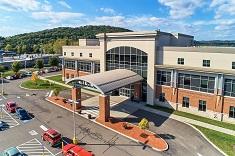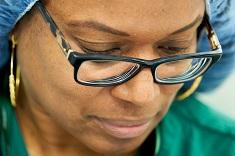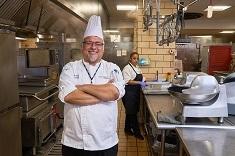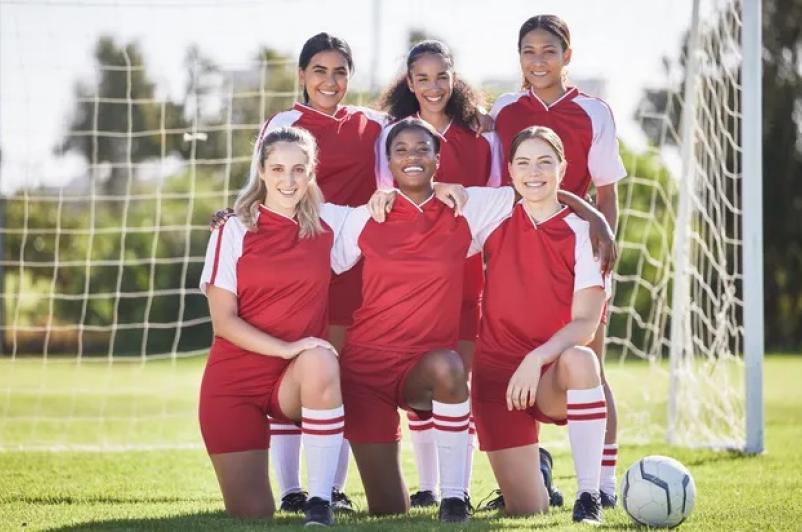
Aubrey Marroquin and Nadia Wojcik were star soccer players at Chenango Valley High School with top-tier, or Division I, college dreams when they experienced injuries that young female athletes are particularly at risk for—repeated-torn ACLs.
Ms. Marroquin’s first knee injury came when she landed roughly during a travel-team game. She was cleared to play six months later. Then, in her fifth high school game of the season, she stepped over the ball wrong and suffered a reinjury. Ms. Wojcik tore her anterior cruciate ligament when she was going around a defender and got pushed from the side during the last game of her junior year high school season, then got hurt again not long after she returned to play. For both girls, the college recruitment process was put in jeopardy.
Although their injuries ended their seasons, they were determined to return to the pitch, or soccer field, and qualify as prospects with top college teams. Since it was both their second time going through the rehabilitation process, they knew they needed to take it more slowly to get back to where they wanted to be. That’s why, just days after surgical repair, they began physical therapy at UHS, eventually graduating to a specially designed approach called the Bridge Program.
A different set of challenges
Marcella Mughetti, PT, DPT, was Ms. Marroquin’s physical therapist at UHS Physical Therapy and Rehabilitation in Vestal. For six months, she worked with Ms. Marroquin one-on-one twice a week and was assigned exercises to complete at home the other five days a week. “Aubrey is a highly motivated athlete,” Dr. Mughetti said. “She was doing really well post-surgically and came in ready to work.”
Dr. Mughetti explained that while physical therapy is most effective when patients are willing to work hard, athletes as driven as Ms. Marroquin present a different challenge. “An athlete at Aubrey’s level needs to be held back a smidge. She had her goals and aspirations in place,” the therapist said. “But since this was her second time tearing the ACL in the same knee, she needed to take her recovery more slowly to safely get her back to a high level of function.”
Site Manager Ben Dvorsky, PT, DPT, had a similar experience with Ms. Wojcik at UHS Physical Therapy and Rehabilitation in Vestal. “Nadia was an easy patient because she was highly motivated to get back to sports and her life and did everything I asked her to do,” he said.
Dr. Dvorsky said that young athletes require a different approach because they may push themselves too quickly if they feel good. On the other hand, they can hold themselves back out of fear of injuring themselves again. “We encourage them to move progressively through exercises, understand their safety boundaries and make sure they are well-healed,” he said.
The physical therapists at UHS maintain professional relationships with high school trainers and coaches, sports medicine physicians and other providers to keep athletes safe and get injured athletes on a path to recovery. For higher-level athletes, the next step in this path after physical therapy is the Bridge Program at UHS Sports Performance.
Back in the game
After six months in physical therapy, Ms. Wojcik and Ms. Marroquin graduated to the Bridge Program with strength and conditioning coach Garvin Taylor, MS, CHC. This program is designed to fill the gap between physical therapy, which focuses on the injured area and the structures supporting it, and the return to sport, which requires athletes to gain back the strength and conditioning they lost after their injury.
The program takes a holistic, whole-body approach by introducing complex exercises that hit on all aspects of sports performance, including cardio, strength, function, stability, balance and conditioning, as well as proprioception, which is the body’s ability to sense motion and locations. “PT focuses on the injured part, and Bridge is where we tie it all together,” said Mr. Taylor. “We’re not just working on preventing re-injury, but on avoiding new injuries as well.”
The typical Bridge Program includes two on-site training sessions a week that last up to two and a half hours each, along with a program to be completed on off days. Each program is individualized and customized to meet the athlete’s goals and work on skills and risk management specific to their sport. For soccer players, that means exercises, like blinded jumps, to teach them to sense where the ground is and land safely while they are looking up at the ball, along with exercises meant to improve single-leg landings and safer horizontal movements.
Before coming to UHS, Mr. Taylor worked with Olympic and national athletes in Grenada, proving the value of a sports performance program with demonstrated results. He applies the same approach and skillset to up-and-coming athletes in the Southern Tier. “There’s something unique about higher-level athletes. You can tell who is going to move forward,” he said. “They have the willingness to sacrifice and work hard to achieve the successes they seek.”
Ms. Marroquin and Ms. Wojcik told Mr. Taylor they wanted to play soccer at Division I colleges since they were children, so he did everything he could to help them meet their goals. They both spoke highly of his approach and attitude that mirrored theirs.
“I wanted to be better than before, so I pushed myself, and so did Garvin. He will make you do things you didn’t think you could do,” said Ms. Marroquin. “His workouts made me sore in places I didn’t think I could be sore!”
Ms. Wojcik echoed: “Garvin is someone I can depend on. I really trusted him to get me stronger and back to playing soccer. Without him, I wouldn’t have regained the confidence to play at a high level. He expects a lot from his athletes, and that’s what I needed.”
“They had days, like everyone else, where they had doubts. The process is long, and there are hills and valleys in the process,” Mr. Taylor said. “That’s where my job is, to continue to motivate them and remind them that tomorrow is a new day. It’s an emotional roller coaster, and that’s where a great coach comes in.”
Strengthening mind and body
“A lot of times, when athletes have a season-ending injury, it can be a challenge for them psychologically as well as physically because they lose their sense of worth when their identity as an athlete is taken away from them,” Dr. Dvorsky said. “It can be difficult for them to visualize living up to their potential.”
Both student athletes benefitted from the emotional support they got from their physical therapists and coaches during their time away from the sport. “I think the hardest part was staying positive the whole time,” said Ms. Marroquin. “It was definitely emotionally challenging not being able to play my senior year.”
“It definitely sucked watching from the sidelines and wishing I could play during the long recovery process,” agreed Ms. Wojcik. “Ben, Garvin and my family all helped me stay positive whenever I had bad days.”
The hard work is paying off, and Ms. Marroquin and Ms. Wojcik’s college soccer dreams are coming true. Today, Ms. Marroquin is a 17-year-old freshman at the University of Houston. She had to sit out the season this year but feels strong enough to try out for a spot on the team in January 2024. Ms. Wojcik, also 17, is now playing on Fairleigh Dickinson University’s Division I team in New Jersey.
Fast access
All five of UHS’ physical therapy clinics offer quick access to get patients established with an individualized plan of care to get them better faster and back to sports, exercise or work. See nyuhs.org for more information about physical therapy at UHS.
UHS is the sports medicine provider for Binghamton University Athletics.


